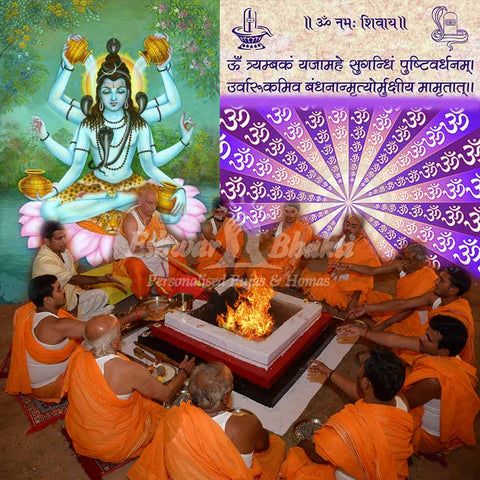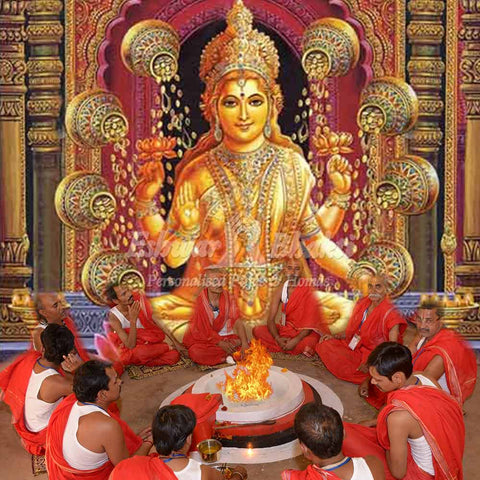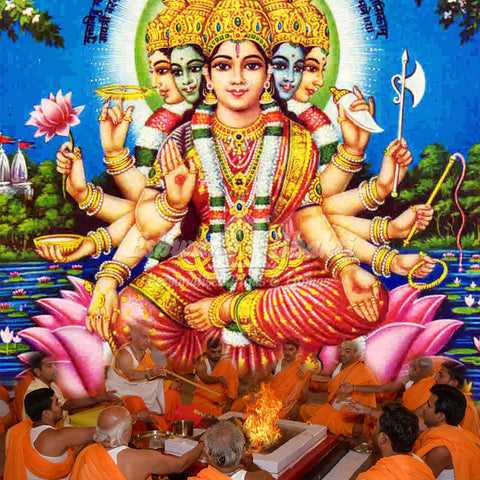What is Mantra?
 The concept of Mantra originated in India during the Vedic period. Mantra is a sacred utterance, which can be a phoneme, syllable, or a group of words. The word, Mantra, comes from the Sanskrit word "man," which means "to think." During the Vedic age, people started chanting Mantra as a part of their meditations. Later on, in the middle of the Vedic Period (between 1000 BC -500 BC), Mantras evolved from the three Vedic texts. They are the Rig Veda, the Sama Veda, and the Yajur Veda. Even today, people continue to recite hymns and verses from these Vedic texts. Mantras have a sacred formula and can enhance us emotionally, spiritually, and psychologically.
The concept of Mantra originated in India during the Vedic period. Mantra is a sacred utterance, which can be a phoneme, syllable, or a group of words. The word, Mantra, comes from the Sanskrit word "man," which means "to think." During the Vedic age, people started chanting Mantra as a part of their meditations. Later on, in the middle of the Vedic Period (between 1000 BC -500 BC), Mantras evolved from the three Vedic texts. They are the Rig Veda, the Sama Veda, and the Yajur Veda. Even today, people continue to recite hymns and verses from these Vedic texts. Mantras have a sacred formula and can enhance us emotionally, spiritually, and psychologically.
As per the Sanskrit text, Amarakosa, there are two types of Mantras. They are Dhatu or seed Mantra and Krit Pratyaya or Ghan. The Seed Mantra can protect us and act as secret speeches. Ghan has a close connection with Karma or Bhava. Mantras are instruments of mind. They can be melodious and have mathematical precision. Sometimes Mantras may not have any literal meaning associated with them. However, they continue to affect us positively. Most of the Mantras that we chant are in Sanskrit and might be hard for us to comprehend. It is essential to understand that Mantras focus on sound and their vibrations rather than on their meanings.
Though chanting of Mantras in Pujas, rituals, and meditation, originated during the Vedic Period, it gradually grew. Different schools of Hinduism started in India, and they included Mantra recitation as their part. Each of these schools has different views and ways of chanting Mantras. For instance, the Tantric School believes the universe is sound, and they give a central position to Mantra recitation. The Tantric School believes that each deity has a Bija or seed Mantra corresponding to them. Another concept associated with Mantra is in Linga Purana. As per the text, Mantra is one of the 1008 names of Lord Shiva.
Significance of Mantra: Chanting of Mantra has several significances. It can help in our physical, psychological, emotional, and spiritual well-being. They can calm and soothe our minds. It is essential to recite or chant them in devotion and faith to the deities. The constant repetition of Mantras can help us embrace positive energies and vibrations. Mantras play a crucial role in yoga practices and meditations as well. Here, we will look into the significances or importances of Mantra recitation in the Hindu belief system.
1. Mantra chanting can help in balancing the imbalances of our Chakras. Each Mantra can activate different parts of our bodies. The seven Chakras in our bodies help in the flow of energy through our bodies. Each of them has frequencies corresponding to them. Chanting Mantras belonging to that frequency can help in curing the imbalances or blockages of our Chakras.
2. Nada yoga is a discipline of yoga that focuses on sound. As per Nada yoga, whenever we utter a sound, it can create powerful forms. So when we recite or chant Mantras in Sanskrit, they can produce representations that help us in imbibing positive energies.
3. The sound formed from wind, trees, and footsteps is also Mantras. As per the belief system, God, in the beginning, manifested on Earth as sound. Everything came into existence from the sound, Om or Aum. It was from the sound, Om, that everything in the world originated. Thus, Mantra is the key to existence.
4. Another significance of Mantra is that it forms an armor or Mantra Kavach. The Mantra Kavach shields and protects our bodies. They can help in changing negative energies to positive vitalities.
5. Chanting the Mantras while you are in a temple or a serene place can help us to improve our concentration. It is a way of transcending from the material aspects of life to the non-material realm. By regular recitation of Mantra, we can come in contact with the Ultimate consciousness of the world or the Brahman.
6. Recitation of Mantras while meditating can solve many problems in our lives. It can also help us move away from depression, hypertension, anxiety, and stress.
These are some of the significances of chanting Mantras. They can play a crucial role in improving our mind-body well-being. They help us in attaining peace, calmness, and solace. You can relieve yourself from frustrations, anger, and stress as well.
How to chant Mantras?: Chanting Mantras is also known as Japa. You can chant Mantras as a part of your meditation, personal prayer, or during Pujas. However, it is essential to chant Mantras correctly. When we recite Mantra in the wrong way, it can have a negative impact. You can chant Mantras in the morning or evening or at any time that suits you. But it is crucial to have a clear mind while you engage in Mantra recitations. You can chant Mantras internally, loudly, or softly. When you chant a Mantra softly, it aids in soothing your nerves. When you recite it as a musical note, it can enchant your heart. It is also essential to learn the correct pronunciation of Mantras for embracing its positive effect.
You can chant each Mantra 108 times. It is auspicious. You can also recite it 5, 10, 28, 1008 times based on the time and length of the Mantra. Most of the devotees have a Japa Mala with 108 beads. They count on them to keep track of their repetitions. After completing an entire cycle, the devotees turn the Mala around to start the second recitation. You can also practice Japa Yagna, where you would be silently repeating the Mantras.
Gayatri Mantra, Shanti Mantra, Ganesh mantra, Durga mantra, Shiva Sutra Mantra, Purusasukta Mantra, and Pavamana Mantra are some of the Mantras chanted by devotees. You can also chant hymns and verses from the Bhagavad Gita, Ramayana, Yoga Sutra, and Mahabharata. Thus, chanting of Mantras can invite positivity and improve our connection with the divine entities. Regular chanting of "Om" can also help you in moving forward in the spiritual path.








